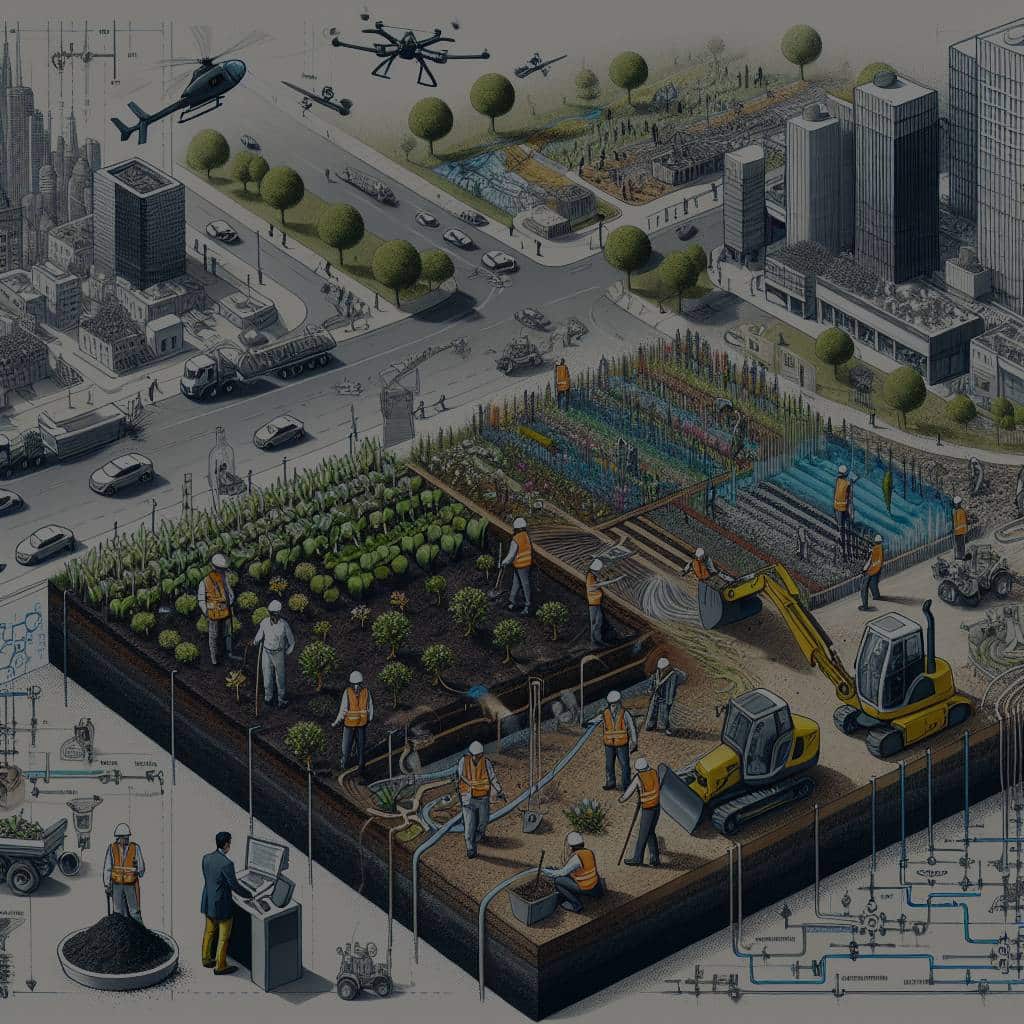What Innovative Techniques Can Be Used for Land Remediation in Urban Development?

Land remediation has emerged as a crucial aspect of urban development. With growing concerns about environmental sustainability, it has become increasingly important to reclaim contaminated lands, ensuring they are safe for use and not harmful to the surrounding environment. This process of soil remediation aims to remove harmful contaminants, which can include heavy metals, from the soil or groundwater.
However, traditional remediation techniques often come with high costs and potential environmental risks. As a result, there is a growing interest in harnessing new technologies and environmentally friendly processes to remediate contaminated sites. This article will explore some of these innovative techniques, from phytoremediation to more advanced technological solutions.
Also read : How to Maximize Space Efficiency in Micro-Apartment Designs?
Phytoremediation: The Power of Plants
Phytoremediation is a remediation technique that uses plants to remove, degrade, or immobilize environmental contaminants in the soil and groundwater. This approach takes advantage of the natural abilities of specific plants to absorb, accumulate, and metabolize various contaminants, including heavy metals.
Research scholars on Google Scholar have published numerous studies on the effectiveness of phytoremediation. For instance, certain plants can accumulate high levels of heavy metals in their tissues without being damaged. These plants, often referred to as hyperaccumulators, can be used to remediate contaminated soils effectively.
Also to read : What Are the Trends in Adaptive Reuse of Vacant Retail Spaces for Residential Purposes?
Phytoremediation offers a low-cost, environmentally friendly remediation option. It can also improve the soil’s physical and chemical properties, making it more conducive for further use, such as urban development.
In-Situ Chemical Oxidation: A Thorough Cleanup
In-Situ Chemical Oxidation (ISCO) is a remediation technology that involves injecting strong oxidants directly into the contaminated site. This process can effectively destroy a wide range of organic contaminants, from petroleum hydrocarbons to chlorinated solvents.
ISCO can be an effective and thorough remediation strategy. However, it requires careful planning and execution. The type and concentration of the oxidant used, the injection method, and the site’s specific characteristics all need to be considered to ensure effective remediation and minimize potential risks.
Despite the complexities, ISCO can provide a rapid, comprehensive cleanup, making it a suitable option for urban development projects with tight schedules and high remediation standards.
Bioremediation: Harnessing Microbial Power
Bioremediation is another innovative and eco-friendly soil remediation technique. It relies on the use of microorganisms, such as bacteria, fungi, and yeast, to break down or transform environmental contaminants into less toxic or non-toxic substances.
Bioremediation is particularly effective for organic pollutants, including petroleum hydrocarbons and certain types of pesticides. It can be implemented in-situ, minimizing the need for soil excavation and the associated environmental impacts.
However, the success of bioremediation depends on the specific conditions of the contaminated site and the types of contaminants present. Therefore, a thorough site assessment and careful selection of the microorganisms used are crucial for effective bioremediation.
Nanoremediation: The Future of Remediation Technology
The field of nanotechnology has opened up new possibilities for soil and groundwater remediation. Nanoremediation involves the use of nanoscale materials, typically reactive iron particles, to degrade or immobilize contaminants.
Nanoremediation offers several advantages over traditional remediation methods. These include the ability to target specific contaminants, the potential for in-situ application, and the capability to treat a wide range of contaminants, from heavy metals to organic pollutants.
Despite its promise, nanoremediation is still a relatively new technology, and further research is needed to fully understand its potential benefits and risks. However, as technology advances, nanoremediation is likely to play an increasingly significant role in urban land remediation.
Electrokinetic Remediation: High-Tech Solution for Heavy Metal Contamination
Electrokinetic remediation is a high-tech solution specifically designed to deal with heavy metal contamination in soil and groundwater. This technology uses a low-intensity electric field to move charged particles, including heavy metal ions, through the soil towards electrodes.
The efficiency of this process depends on several factors, including the soil’s composition, the type of contaminants, and the electric field’s strength. Despite these complexities, electrokinetic remediation can be a highly targeted and effective technique for heavy metal contamination, making it a valuable tool for urban land remediation.
In conclusion, while traditional remediation methods still have their place, these innovative techniques offer promising alternatives for urban development. As technology and our understanding of these processes improve, they are likely to become more prevalent in our efforts to reclaim contaminated lands for urban use.
Sustainable Remediation: The Way Forward for Urban Development
Sustainable remediation is an emerging field that integrates social, economic, and environmental considerations into the land remediation process. This holistic approach aims to maximize the benefits and minimize the negative impacts of remediation activities on human health, the economy, and the environment.
Scholars on Google Scholar have published comprehensive studies demonstrating the effectiveness of sustainable remediation strategies in urban development. These strategies often incorporate a variety of remediation technologies, including phytoremediation, bioremediation, and nanoremediation, to ensure a comprehensive and effective cleanup of contaminated sites.
On the cost perspective, sustainable remediation strategies can be more cost-effective in the long term. Although the upfront investment may be higher than traditional methods, the long-term benefits, including improved human health and environmental protection, can outweigh the initial costs.
Adapting to climate change is another significant advantage of sustainable remediation. By considering the potential impacts of climate change on the remediation process and designing flexible and resilient remediation systems, sustainable remediation can help ensure the long-term success of urban development projects.
In the realm of chemical engineering, sustainable remediation has made significant strides. New technologies and techniques are being developed to address the unique challenges posed by different types of contaminants, from heavy metals to organic pollutants. As our understanding of these contaminants and their interactions with the environment improves, so too will our ability to remediate contaminated soils effectively and sustainably.
Conclusion: Embracing Innovation for a Greener Future
The growing body of research on soil contamination and remediation technology clearly indicates that remediation is not a one-size-fits-all solution. Instead, a variety of innovative and sustainable remediation techniques are needed to address the diverse range of contaminants found in urban environments.
From harnessing the power of plants and microorganisms in phytoremediation and bioremediation, to leveraging the precision and efficiency of nanoremediation and electrokinetic remediation, these innovative techniques offer promising solutions for reclaiming contaminated lands.
However, the journey of land remediation does not end with the removal of contaminants. To truly achieve sustainable urban development, we must also consider how to restore and enhance the soil’s health and function after remediation. This might include strategies such as improving the soil’s structure and fertility, cultivating beneficial microorganisms, and promoting biodiversity.
Moving forward, we will need to continue advancing our remediation technologies and strategies. This will require ongoing research, collaboration across disciplines, and engagement with stakeholders, including local communities and policymakers. By doing so, we can ensure that our urban development efforts are not only economically viable, but also environmentally sustainable and beneficial to human health.
In conclusion, land remediation in urban development is a complex and multifaceted challenge. However, with the innovative remediation techniques explored in this article and a commitment to sustainable practices, we can turn our contaminated lands into thriving urban environments. As we continue to confront the environmental challenges of the 21st century, these groundbreaking techniques will be our powerful allies in creating a greener, healthier, and more sustainable future.
